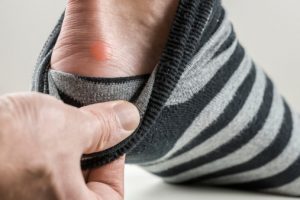
Prevention is your number one defense from painful blisters. Dr. Anthony Rossi, an assistant professor of dermatology at Memorial Sloan Kettering Cancer Center, explained, “To stop them before they appear, pay attention to your skin and take precautions if you know you’re going to do a lot of walking, running, or other physical activity.”
Here are some prevention tips from Dr. Rossi to help enjoy a blister-free summer:
- Wear socks. Try nylon and moisture-wicking socks, and throw on an extra pair if one doesn’t do the trick. Avoid shoes that are too tight or too loose.
- When you’re active, wear moisture-wicking, loose-fitting clothes. Beware of cotton clothes – these can cause friction as they soak up sweat and moisture.
- Soft bandages, such as adhesive moleskin, can protect vulnerable areas like the feet and thighs. Apply them securely to avoid further problems.
- To prevent friction, apply powder or petroleum jelly.
- If you feel pain or if your skin gets red, stop physical activity.
If you do end up getting a blister, Dr. Rossi suggests you leave it alone. Usually, a blister will heal on its own, so don’t cause any further irritation. Be mindful, however, of what caused your blister in the first place and avoid any activities that can aggravate your condition and cause you more pain.
Here are some treatment recommendations from Dr. Rossi in case you develop one of these seemingly inescapable summer attributes:
- Cover the blister loosely with a bandage, raising it a bit in the middle. Consider padding to protect blisters in places like the bottom of your foot. Cut padding into a donut shape and place it around the blister.
- Do not pop or drain the blister, unless it is large and painful. If you must drain it, pierce the edge of the blister, not the top, using a small needle sterilized with rubbing alcohol.
- Keep the blister area clean and covered. Wash it with soap and water after it’s drained and cover it with petroleum jelly.
Dr. Rossi concluded, “As your blister heals, watch for signs of an infection. If you notice any redness, pus, or increased pain or swelling, make an appointment to see your doctor or a board-certified dermatologist.”
Also, read Bel Marra Health’s article: How not to gain weight this summer.